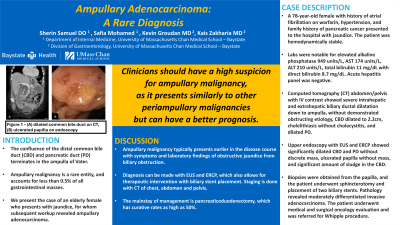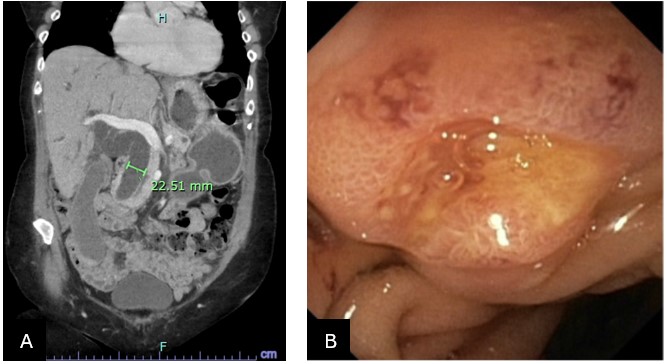Monday Poster Session
Category: Biliary/Pancreas
P1857 - Ampullary Adenocarcinoma: A Rare Diagnosis
Monday, October 28, 2024
10:30 AM - 4:00 PM ET
Location: Exhibit Hall E

Has Audio

Sherin Samuel, DO
University of Massachusetts Chan Medical School - Baystate
Springfield, MA
Presenting Author(s)
Sherin Samuel, DO, Safia Mohamed, MD, Kevin Groudan, MD, Kais Zakharia, MD
University of Massachusetts Chan Medical School - Baystate, Springfield, MA
Introduction: The confluence of the distal common bile duct (CBD) and pancreatic duct (PD) terminates in the ampulla of Vater. Ampullary malignancy is a rare entity, and accounts for less than 0.5% of all gastrointestinal masses. We present the case of an elderly female who presents with jaundice, for whom subsequent workup revealed ampullary adenocarcinoma.
Case Description/Methods: A 78-year-old female with history of atrial fibrillation on warfarin, hypertension, and family history of pancreatic cancer presented to the hospital with jaundice. The patient was hemodynamically stable. Labs were notable for elevated alkaline phosphatase 949 units/L, aspartate aminotransferase (AST) 174 units/L, alanine aminotransferase (ALT) 210 units/L, total bilirubin 11 mg/dL with direct bilirubin 8.7 mg/dL. Acute hepatitis panel was negative. Computed tomography (CT) abdomen/pelvis with intravenous contrast showed severe intrahepatic and extrahepatic biliary ductal dilatation down to ampulla, without demonstrated obstructing etiology, CBD dilated to 2.2cm, cholelithiasis without cholecystitis, and dilated PD. Upper endoscopy with endoscopic ultrasound (EUS) and endoscopic retrograde cholangiopancreatography (ERCP) showed significantly dilated CBD and PD without discrete mass, ulcerated papilla without mass, and significant amount of sludge in the CBD. Biopsies were obtained from the papilla, and the patient underwent sphincterotomy and placement of two biliary stents. Pathology revealed moderately differentiated invasive adenocarcinoma. The patient underwent medical and surgical oncology evaluation and was referred for Whipple procedure.
Discussion: Ampullary malignancy typically presents earlier in the disease course with symptoms and laboratory findings of obstructive jaundice from biliary obstruction. Diagnosis can be made with EUS and ERCP, which also allows for therapeutic intervention with biliary stent placement. Staging is done with CT of chest, abdomen and pelvis. The mainstay of management is pancreaticoduodenectomy, which has curative rates as high as 50%. Clinicians should have a high suspicion for ampullary malignancy, as it presents similarly to other periampullary malignancies but can have a better prognosis.

Disclosures:
Sherin Samuel, DO, Safia Mohamed, MD, Kevin Groudan, MD, Kais Zakharia, MD. P1857 - Ampullary Adenocarcinoma: A Rare Diagnosis, ACG 2024 Annual Scientific Meeting Abstracts. Philadelphia, PA: American College of Gastroenterology.
University of Massachusetts Chan Medical School - Baystate, Springfield, MA
Introduction: The confluence of the distal common bile duct (CBD) and pancreatic duct (PD) terminates in the ampulla of Vater. Ampullary malignancy is a rare entity, and accounts for less than 0.5% of all gastrointestinal masses. We present the case of an elderly female who presents with jaundice, for whom subsequent workup revealed ampullary adenocarcinoma.
Case Description/Methods: A 78-year-old female with history of atrial fibrillation on warfarin, hypertension, and family history of pancreatic cancer presented to the hospital with jaundice. The patient was hemodynamically stable. Labs were notable for elevated alkaline phosphatase 949 units/L, aspartate aminotransferase (AST) 174 units/L, alanine aminotransferase (ALT) 210 units/L, total bilirubin 11 mg/dL with direct bilirubin 8.7 mg/dL. Acute hepatitis panel was negative. Computed tomography (CT) abdomen/pelvis with intravenous contrast showed severe intrahepatic and extrahepatic biliary ductal dilatation down to ampulla, without demonstrated obstructing etiology, CBD dilated to 2.2cm, cholelithiasis without cholecystitis, and dilated PD. Upper endoscopy with endoscopic ultrasound (EUS) and endoscopic retrograde cholangiopancreatography (ERCP) showed significantly dilated CBD and PD without discrete mass, ulcerated papilla without mass, and significant amount of sludge in the CBD. Biopsies were obtained from the papilla, and the patient underwent sphincterotomy and placement of two biliary stents. Pathology revealed moderately differentiated invasive adenocarcinoma. The patient underwent medical and surgical oncology evaluation and was referred for Whipple procedure.
Discussion: Ampullary malignancy typically presents earlier in the disease course with symptoms and laboratory findings of obstructive jaundice from biliary obstruction. Diagnosis can be made with EUS and ERCP, which also allows for therapeutic intervention with biliary stent placement. Staging is done with CT of chest, abdomen and pelvis. The mainstay of management is pancreaticoduodenectomy, which has curative rates as high as 50%. Clinicians should have a high suspicion for ampullary malignancy, as it presents similarly to other periampullary malignancies but can have a better prognosis.

Figure: Figure 1 – (A) dilated common bile duct on CT, (B) ulcerated papilla on endoscopy
Disclosures:
Sherin Samuel indicated no relevant financial relationships.
Safia Mohamed indicated no relevant financial relationships.
Kevin Groudan indicated no relevant financial relationships.
Kais Zakharia indicated no relevant financial relationships.
Sherin Samuel, DO, Safia Mohamed, MD, Kevin Groudan, MD, Kais Zakharia, MD. P1857 - Ampullary Adenocarcinoma: A Rare Diagnosis, ACG 2024 Annual Scientific Meeting Abstracts. Philadelphia, PA: American College of Gastroenterology.
